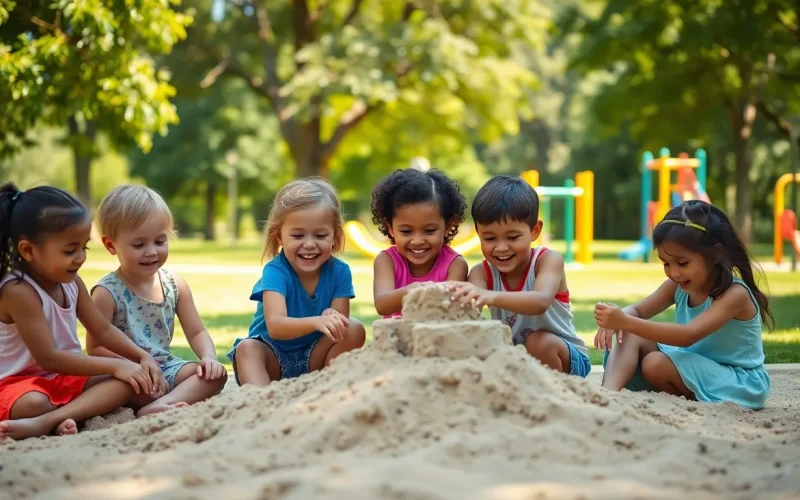Table of Contents
ToggleIn a world where kids seem to have endless energy and an affinity for turning every living room into a mini wrestling ring, the importance of child wellbeing often gets sidelined. But let’s face it—happy, healthy kids are the secret sauce to a thriving society. When children feel secure and supported, they grow into confident adults who can tackle life’s challenges, like finding their shoes or figuring out how to negotiate snack time.
Child wellbeing isn’t just about avoiding tantrums or keeping them from eating an entire bag of gummy bears. It’s about nurturing their emotional, physical, and social development. By focusing on their wellbeing today, we’re investing in a brighter future, one where kids can laugh, learn, and maybe even share their toys (occasionally). So let’s dive into what makes child wellbeing essential and how we can all play a part in raising the next generation of superstar humans.
Understanding Child Wellbeing
Child wellbeing refers to the holistic development of children across various aspects of life. This concept plays a crucial role in shaping future adults who can effectively contribute to society.
Definition and Importance
Child wellbeing encompasses emotional, physical, and social dimensions. Healthy emotional development enhances resilience, enabling children to manage stress and build relationships. Physical health, characterized by proper nutrition and regular exercise, is essential for growth and preventing illness. Social development fosters skills like communication and teamwork, which are vital for navigating life. Investing in these areas cultivates confident individuals capable of overcoming challenges. Research shows that prioritizing child wellbeing leads to long-term benefits for society, such as reduced healthcare costs and improved educational outcomes. These factors underline the importance of ensuring a supportive environment for every child.
Dimensions of Child Wellbeing
Child wellbeing consists of multiple dimensions that contribute to a child’s overall health. Emotional wellbeing includes aspects such as self-esteem, emotional regulation, and the ability to express feelings. Physical wellbeing involves aspects like nutrition, exercise, and sleep habits. Social wellbeing emphasizes the importance of having supportive relationships with peers and adults, fostering a sense of belonging and community. Cognitive development shapes critical thinking and problem-solving abilities, crucial for academic success. Each dimension interacts with others; thus, addressing them collectively enhances overall wellbeing. Ensuring a balanced approach across these dimensions equips children with the tools to thrive in life.
Factors Influencing Child Wellbeing

Child wellbeing depends on various interconnected factors that shape a child’s overall development. Each aspect plays a significant role in fostering a supportive environment for children.
Family Environment
The family environment serves as the primary influence on a child’s emotional and social development. Supportive families provide children with love, stability, and guidance. Parents or caregivers who engage in positive communication and show affection help cultivate self-esteem. When families foster secure attachments, children develop resilience and coping mechanisms for life’s challenges. Positive family dynamics promote healthy emotional development, ultimately shaping children’s future relationships and interactions.
Socioeconomic Status
Socioeconomic status significantly impacts access to resources and opportunities for children. Higher incomes correlate with better nutrition, healthcare, and educational prospects. Families facing economic hardship often struggle to meet basic needs, affecting children’s physical health and emotional stability. Additionally, limited financial resources restrict access to extracurricular activities that promote social connections. Socioeconomic barriers create challenges that can hinder children’s overall development and wellbeing.
Education and Access to Resources
Education and access to resources lay the foundation for a child’s cognitive and social growth. Quality education enhances critical thinking, problem-solving, and social skills. Schools that provide supportive environments foster engagement and motivation, essential for academic success. Access to libraries, recreational facilities, and community programs enrich learning experiences. When children have exposure to diverse resources, they develop a broader perspective on life, helping them navigate challenges more effectively.
Measuring Child Wellbeing
Measuring child wellbeing involves evaluating various indicators that reflect children’s overall health and development. These indicators help gauge the effectiveness of interventions and strategies aimed at improving outcomes.
Common Indicators
Common indicators include emotional resilience, physical health, and social skills. Emotional resilience relates to children’s ability to manage stress and express emotions. Physical health encompasses nutrition, exercise, and general wellness. Social skills reflect children’s ability to form positive relationships and communicate effectively with peers. Education quality and access to resources also play a significant role, as they impact cognitive development and learning success. Each of these indicators reveals insights into the wellbeing of children, guiding efforts towards enhancement and support.
Tools and Assessments
Various tools and assessments exist to measure child wellbeing accurately. Surveys assess emotional and social development, capturing children’s experiences and perceptions. Health screenings monitor physical health metrics, identifying areas that require intervention. Standardized tests evaluate cognitive abilities and academic performance, providing benchmarks for growth. Parent and teacher observations offer qualitative insights into children’s behavior and social interactions. These instruments collectively inform policymakers, educators, and families about effective strategies for promoting child wellbeing.
Promoting Child Wellbeing
Promoting child wellbeing involves a collaborative approach that engages communities, schools, and government entities. These sectors create supportive environments that enhance children’s development.
Community Initiatives
Community initiatives play a vital role in enriching child wellbeing. Local organizations often implement programs that provide resources for families, such as parenting classes and health workshops. Events that focus on children’s mental health raise awareness and foster supportive networks. Furthermore, community engagement activities encourage children to participate in sports or arts, nurturing self-esteem and social skills. Such initiatives bridge gaps and ensure that children access the support they need to thrive.
Role of Schools and Educators
Schools and educators significantly impact children’s holistic development. They create inclusive environments that promote emotional and social learning. Implementing curricula that incorporate social-emotional learning equips students with essential skills for managing emotions and building relationships. Teachers often serve as mentors, providing guidance and support that fosters children’s resilience. Regular communication with families helps ensure that children’s needs are recognized, leading to better academic and emotional outcomes.
Government Policies and Support
Government policies and support systems are crucial for advancing child wellbeing. Policies that ensure access to quality healthcare and nutritious food can alleviate disparities in children’s development. Programs providing funding for early childhood education help to level the playing field, offering all children a strong foundation. Legislative measures that protect children’s rights safeguard their welfare and create an environment conducive to learning and growth. Investing in these areas leads to long-term societal benefits by promoting healthier future generations.
Child wellbeing is an essential foundation for a prosperous future. By nurturing emotional, physical, and social development, society ensures that children grow into resilient and capable adults. The interplay of these dimensions highlights the importance of a balanced approach to wellbeing.
Investing in supportive family environments and quality education creates a ripple effect that benefits not only the individual child but the community as a whole. Collaborative efforts among families, schools, and policymakers pave the way for healthier generations.
Prioritizing child wellbeing isn’t just a responsibility; it’s a commitment to fostering a thriving society where every child has the opportunity to succeed. Together, by focusing on these crucial aspects, a brighter future can be built for all.





